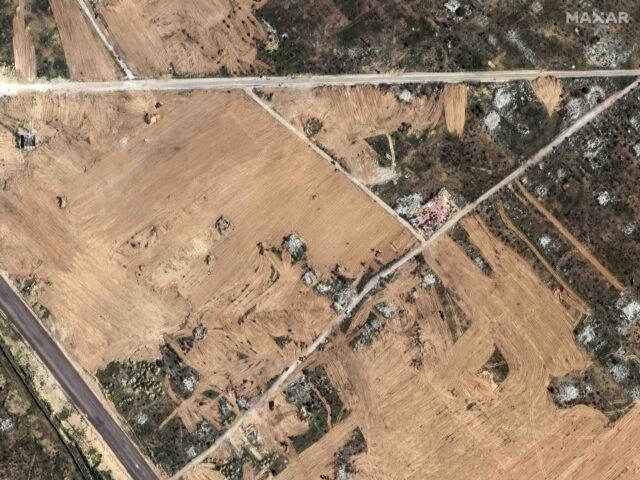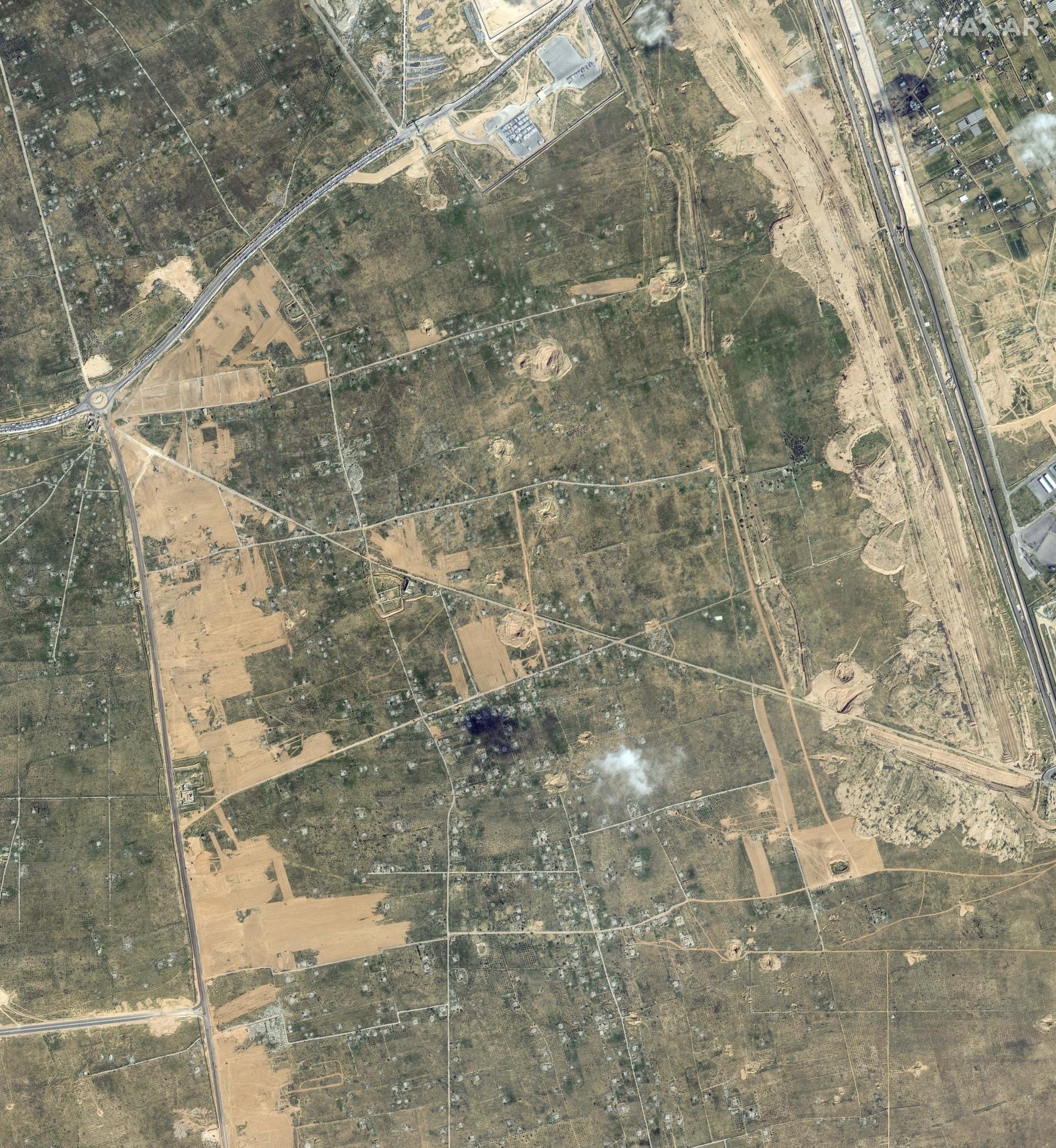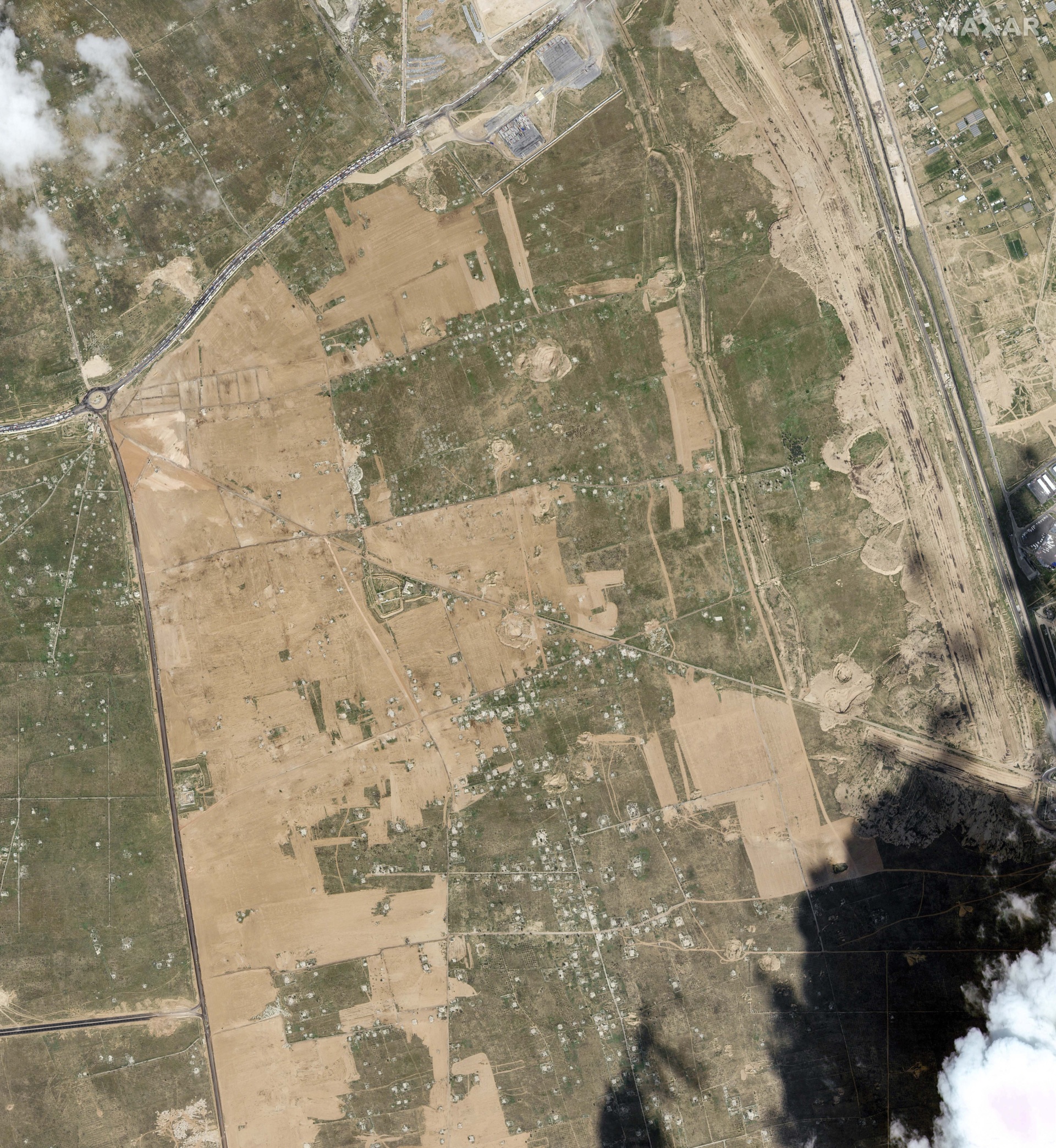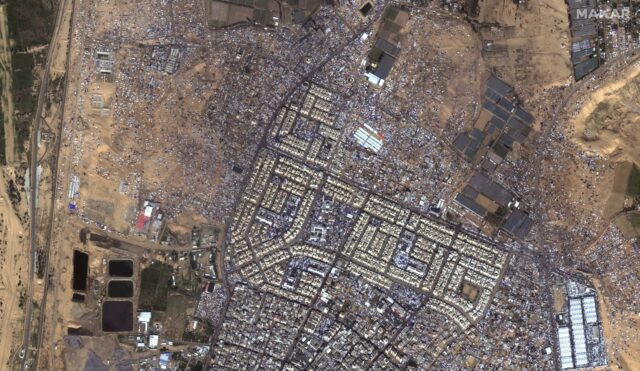Satellite images taken by the firm Maxar Technologies and shared with several American news agencies on Thursday and Friday appear to show the construction of a new wall near the border between Egypt and Rafah, Gaza, as Israel prepares to attack Hamas terrorists in that city.
The photos, released via the Associated Press, appear to show Egypt building a walled enclosure next to its border with Gaza, possibly in preparation for an influx of temporary Palestinian refugees from Rafah. The images suggest that Egypt, despite objecting publicly to an Israeli offensive against Hamas in Rafah, is quietly helping Israel by providing a place to which Palestinian civilians can flee while Israel targets the last four Hamas terrorist battalions in Gaza.
The Associated Press noted that the photos “correspond to features seen in a video released by the London-based Sinai Foundation for Human Rights on Feb. 12,” corroborating the legitimacy of the images. The agency described the construction as taking place “along the Sheikh Zuweid-Rafah Road some 3.5 kilometers (2 miles) west of the border with Gaza.”
“The images show cranes, trucks and what appear to be precast concrete barriers being set up along the road,” AP added, also observing evidence that construction was ongoing “nearby … for an unknown purpose.”

This satellite image provided by Maxar Technologies shows earth grading activity during buffer zone construction in Rafah, Egypt, Saturday, Feb. 10, 2024. (Maxar Technologies via AP)

This satellite image provided by Maxar Technologies shows buffer zone construction in Rafah, Egypt, Saturday, Feb. 10, 2024. (Maxar Technologies via AP)

This satellite image provided by Maxar Technologies shows wall construction in Rafah, Egypt, Thursday, Feb. 15, 2024. (Maxar Technologies via AP)
The Egyptian national government has not commented on the report at press time. The governor of the North Sinai region, Mohamed Abdel-Fadil Shousha, did issue a statement on Thursday denying “rumors” that the purpose of the new construction is to house Palestinians.
“The governor indicated the ongoing work in the Egyptian city of Rafah — located to the west of the Palestinian Rafah across the Egypt-Gaza border — concerns cataloging buildings demolished during the country’s recent war on terrorism,” the Egyptian newspaper al-Ahram reported.
Egyptian strongman Abdel Fattah al-Sisi has enthusiastically rejected the idea of accepting any Palestinian refugees, despite claiming that his regime generally supports the Palestinian “cause” against Israel. In the early days after October 7, Sisi boasted that Egypt had “nine million guests … from many countries,” but Palestinians were “different” and unwelcome in the country as “the [Palestinian] cause is the top cause of all Arabs.”
“It is important that [Palestinian] people remain steadfast and present on their lands,” Sisi said at the time.
On October 18, Sisi claimed he could not take in any Palestinian refugees because, “if it came to it, I could call on the Egyptian people to come out and express their rejection of this proposal, and you would see millions of Egyptians.”
Sisi suggested stranding Palestinian refugees in the Negev desert, instead.
“If there is an idea to displace Palestinians from Gaza, why not transfer them to the Negev until the armed groups in Gaza, such as Hamas and PIJ, are eliminated?” he asked.
The government of U.S. President Joe Biden has supported Sisi’s refusal to take in refugees, despite huge leverage over Egypt due to American aid. In a conversation with Sisi on February 6, Secretary of State Antony Blinken “emphasized the United States’ rejection of any forced displacement of Palestinians from Gaza and commitment to establishing a Palestinian state that provides peace and security for Israelis and Palestinians alike.”
Similarly, in November, Biden spoke to Sisi personally, expressing “that under no circumstances will the United States permit the forced relocation of Palestinians from Gaza or the West Bank, or the besiegement of Gaza, or the redrawing of the borders of Gaza.”
Sisi’s rejections are a response to the displacement of thousands of people in self-defense operations that began after the October 7 Hamas attack on Israel, in which terrorists invaded the country from their stronghold in Gaza and engaged in mass killings, gang rape, infanticide, the torching of entire residential communities, and other atrocities. An estimated 1,200 people were killed on October 7.
Hamas routinely uses Palestinian civilians as human shields, placing critical terrorist infrastructure in residential areas, hospitals, and schools, among other sensitive sites.
Israel’s self-defense operations began in northern Gaza but have moved southward as the country seeks to rescue dozens of hostages still believed to be in jihadist control in the area. Hamas is believed to have initially taken 243 hostages, of which the Israeli government believes roughly 100 are still alive and in Gaza.
On February 9, Israeli Prime Minister Benjamin Netanyahu announced that he would send the Israel Defense Forces (IDF) into Rafah, after preparing a plan for the evacuation of Palestinian civilians.
“It is impossible to achieve the goal of the war of eliminating Hamas by leaving four Hamas battalions in Rafah,” Netanyahu said at the time. “On the contrary, it is clear that intense activity in Rafah requires that civilians evacuate the areas of combat.”
Shortly thereafter, the IDF announced the rescue of two more hostages.

COMMENTS
Please let us know if you're having issues with commenting.